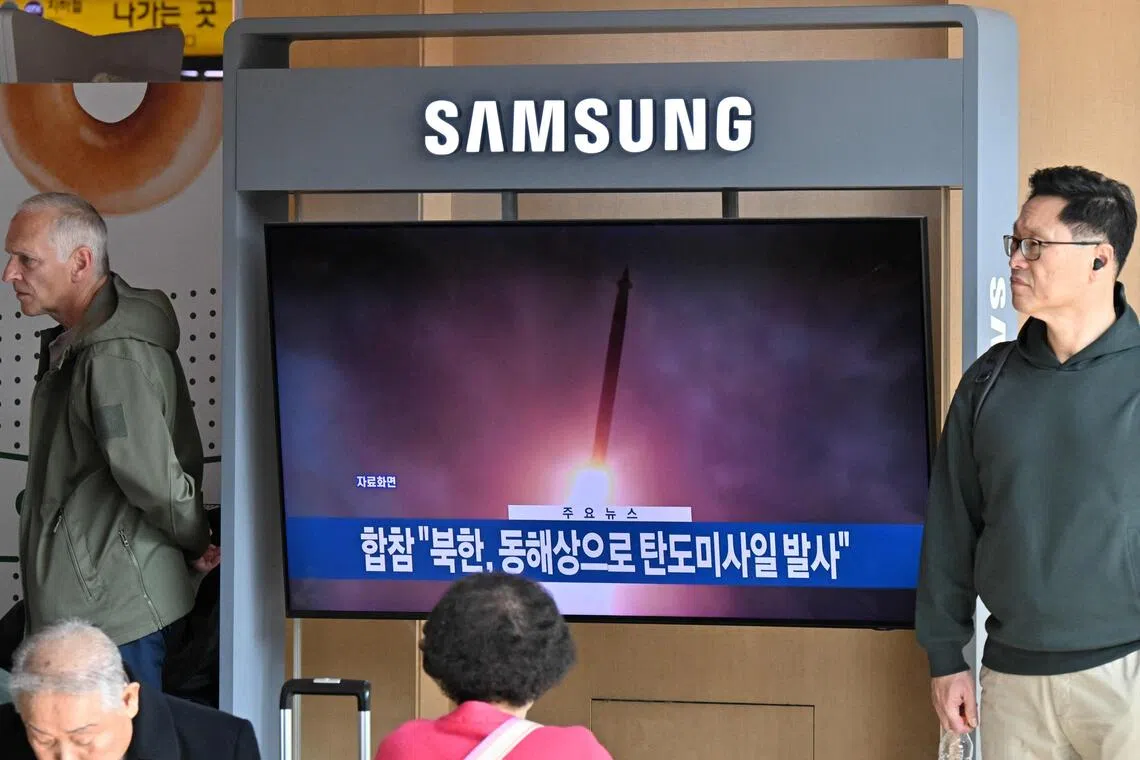North Korea fires unidentified ballistic missile: Seoul military
Sign up now: Get ST's newsletters delivered to your inbox

People standing next to a television showing a news broadcast with file footage of a North Korean missile test, at a railway station in Seoul on Nov 7, 2025.
PHOTO: AFP
Follow topic:
SEOUL - North Korea fired at least one ballistic missile on Nov 7, Seoul’s military said, around a week after US President Donald Trump approved South Korea’s plan to build a nuclear-powered submarine.
Analysts have said Seoul’s plan to build one of the atomic-driven vessels would likely draw an aggressive response from Pyongyang.
South Korea’s Joint Chiefs of Staff said North Korea fired an unidentified ballistic missile towards the East Sea, referring to the body of water also known as the Sea of Japan.
The missile has already landed in the sea outside Japan’s economic waters and no damage or injuries have been reported, said Japanese Prime Minister Sanae Takaichi.
North Korea has significantly increased missile testing in recent years, which analysts say is aimed at improving precision strike capabilities, challenging the US as well as South Korea, and testing weapons before potentially exporting them to Russia.
“From North Korea’s perspective, the possibility of sudden attacks from the East Sea will be a source of anxiety,” Mr Ahn Chan-il, a defector-turned-researcher who runs the World Institute for North Korea Studies, told AFP.
“If South Korea acquires a nuclear-powered submarine, it would be able to enter North Korean waters and pre-emptively monitor or intercept weapons such as submarine-launched ballistic missiles.”
Mr Trump had announced that South Korea would build the submarine in the US
Unlike diesel-powered submarines, which must regularly surface to recharge their batteries, nuclear-powered ones can remain submerged for far longer.
‘Irreversible’ nuclear state
Analysts say developing a nuclear-powered submarine would mark a significant leap in South Korea’s naval and defence industrial base, joining a select group of countries with such vessels.
Only the US, Australia, China, Russia, India, France and Britain have moved towards nuclear-powered submarines, according to media and analysis reports.
Since North Korean leader Kim Jong Un’s 2019 summit with Mr Trump collapsed over the scope of denuclearisation and sanctions relief, Pyongyang has repeatedly declared itself an “irreversible” nuclear state.
Mr Kim has since been emboldened by the war in Ukraine, securing critical support from Moscow after sending thousands of troops
Pyongyang did not respond to Mr Trump’s offer to meet Mr Kim last week, and instead its Foreign Minister Choe Son Hui headed to Moscow, where she and Russian President Vladimir Putin agreed to strengthen bilateral ties.
In September, Mr Kim appeared alongside Chinese President Xi Jinping
Mr Trump met Mr Kim three times during his first term and once famously said the pair had fallen “in love”, but he ultimately failed to secure a lasting agreement on North Korea’s nuclear programme.
Their meeting, however, did not take place last week.
But South Korean lawmaker Lee Seong-kweun said earlier this week Seoul’s spy agency believes Mr Kim was still open to talks with Washington “and will seek contact when the conditions are in place”.
Although the proposed meeting with Mr Trump did not materialise, “multiple signs suggest” that Pyongyang “had been preparing behind the scenes for possible talks with the US”, said the lawmaker. AFP

